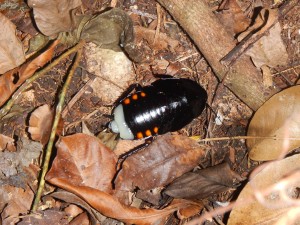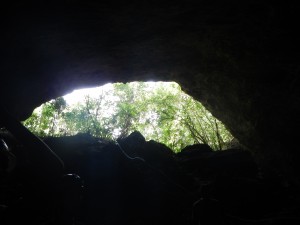What an exciting evening! After collecting our traps, gathering data, and finding seven species of roaches in those traps, we finally had our night-hike through the Maya Trail where we could see the forest activity in the nighttime. So many cockroaches were active at the time, nymphs and adults, large and small, colorful and drab! Most cockroaches that we see in the wild are drab in color, which helps facilitate their ability to hide on trees and in leaf litter. However, today’s hike has shown me BY FAR the strangest roach I had ever seen!
This roach was huge, probably a maximum of 10 cm, and had no wings, giant legs, and 6 orange dots towards the edge of its abdomen. However, it’s last two segments, which would supposedly be covered by exoskeleton was strangely white, soft, and exposed. I thought it was in the process of molting, since molted roaches are indeed white in color, but roaches molt from the head to tail, not the other way around. My only thoughts were that this big buddy had unfortunately been attacked and lost some of its exoskeleton. As I found ants all over the forest floor, I figured this magnificent creature was doomed to be ant food.
A few moments later, I heard a call from my colleagues. A roach of the exact same appearance had been spotted, complete with the strange white butt. It was then, I thought, two roaches, with the exact same body as each other, therefore the white end cannot be an accident. In excitement, I decided to capture a specimen for a closer look. Then the unexpected happened.
The white end exudes a sticky, dry fasting glue when the roach is distressed. Not only that, but when I had gotten the roach into my container, it suddenly hissed. This hiss is not your ordinary cat hiss or your ordinary roach hiss, which is short and sudden. This was a long, loud, sustained, and violent hissing (for a few seconds) on the roach’s part. It was almost as if it were a scream. It definitely scared most of the people with me, and it almost gave me a heart attack! Not only was this specimen not documented in my research, but this behavior of glue defenses and sustained hissing was unheard of, even to my instructors. Perhaps it was this reason, that the roach could sit openly in the field surrounded by ants. It has many defenses up its sleeve for protection.
Afterwards, I released the roach back into the wild, where it slowly waddled away, seemingly exhausted from the stressful ordeal. Definitely one of the coolest specimens I have ever come across and I hope to read more about it when I go back!
Other than that roach, I found many nymphs as well as a giant black roach spanning 6 or more inches or about the size of my hand!








